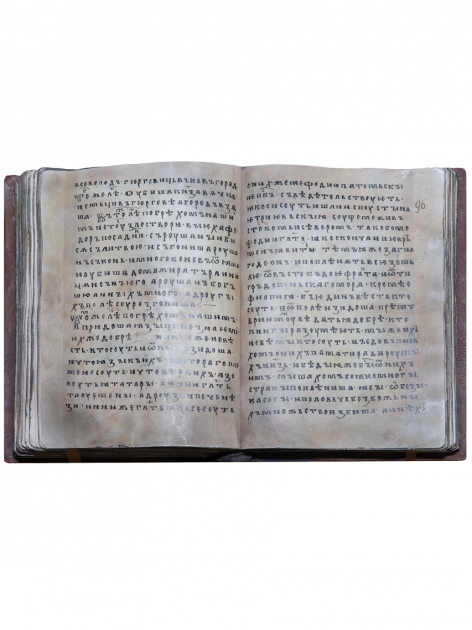Novgorod I Chronicle. Senior edition

Novgorod I Chronicle of the senior edition - is a pride of the manuscript collection of the museum. The oldest chronicle of the Great Novgorod remained in two editions: senior and junior. The senior edition is represented by the only parchment list, which is dated from the XIII and the XIV centuries and is one of the oldest remained ancient Russian chronicle manuscripts. The narration in the older part of the chronicle reaches the middle of the XIV century. The Chronicle describes the battle on Kalka (May 31, 1223 - between the combined Russian-Polovtsian and Mongolian troops), the Mongol invasion of 1237-1238, and the Battle of Rakovor (February 18, 1268 - between the combined forces of the Russian appanage princes, Novgorodians and Pskovians, and the army of Danes and Livonian knights).
A detailed description of events relating mainly to the history of the Novgorod boyar republic makes this artifact an invaluable source for studying political history, international relations, the economy and the daily life of a medieval city. The text of the Chronicle is a source of a special interest for philologists. It allowed scholars to reconstruct the Novgorodian dialect of the Old Russian language.
It is opened on the story of the Batu invasion to Russia in 1237.
It is the oldest chronicle of the Great Novgorod. It is known in two editions: senior and junior. The senior edition, created in the Yuriev Monastery of the Great Novgorod, is represented by the only parchment list, which is dated from the 13th and 14th centuries and is one of the oldest remained ancient Russian chronicle manuscripts. Part of the chronicle until 1234 was written in two handwritings of the end of the 13th century, one of which was attributed by scholars to the hand of the sexton of the church of St. Jacob from Lyudin End of Novgorod - Timothy. The other part brings the narration up to the 1330s and has postscripts, made in different handwritings and ending in the middle of the XIV century. The notebook outlining events of 1273-1298 is lost.
The Chronicle describes the battle on Kalka (May 31, 1223 - between the combined Russian-Polovtsian and Mongolian troops), the Mongol invasion of 1237–1238, and the Battle of Rakovor (February 18, 1268 - between the combined forces of the Russian appanage princes, Novgorodians and Pskovians, and the army of Danes and Livonian knights).
A detailed description of events relating mainly to the history of the Novgorod boyar republic makes this monument an invaluable source for studying political history, international relations, the economy and the daily life of a medieval city. The text of the Chronicle is a source of a special interest for philologists. It allowed scholars to reconstruct the Novgorodian dialect of the Old Russian language.
St. Yuriev Monastery stands on the bank of the Volkhov River near the Lake Ilmen. According to the legend, it was founded by Prince Yaroslav the Wise in 1030. The first chronicle mention of it dates back to 1119, when the decree of Prince Vsevolod Mstislavovich laid the St. George Cathedral, one of the most remarkable works of ancient Russian architecture, created by craftsman Peter, the first Russian architect, whose name is mentioned in chronicles. In the Middle Ages, the monastery was the spiritual center of the Novgorodian land.
It is opened on the story of the Batu invasion to Russia in 1237.
